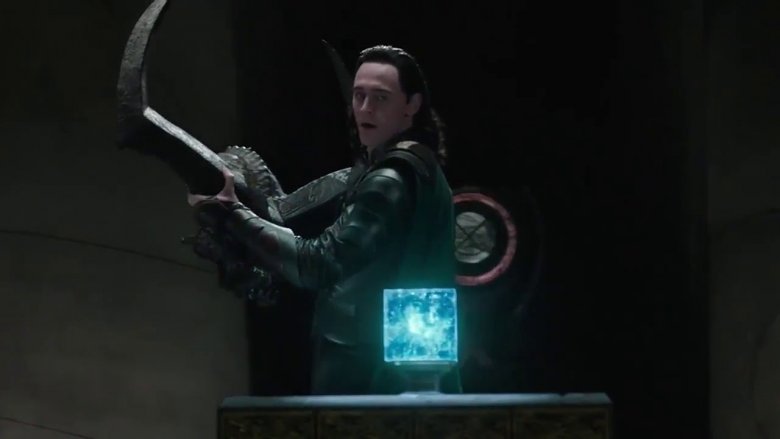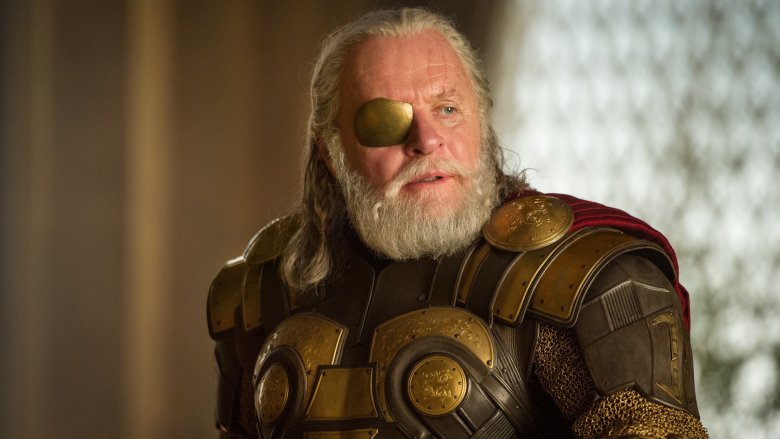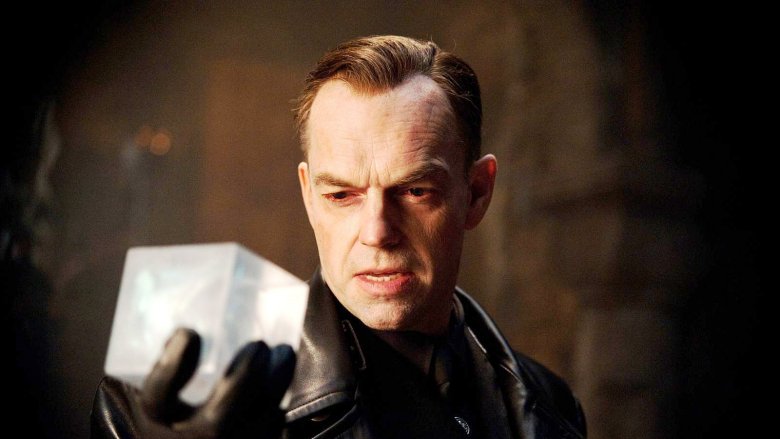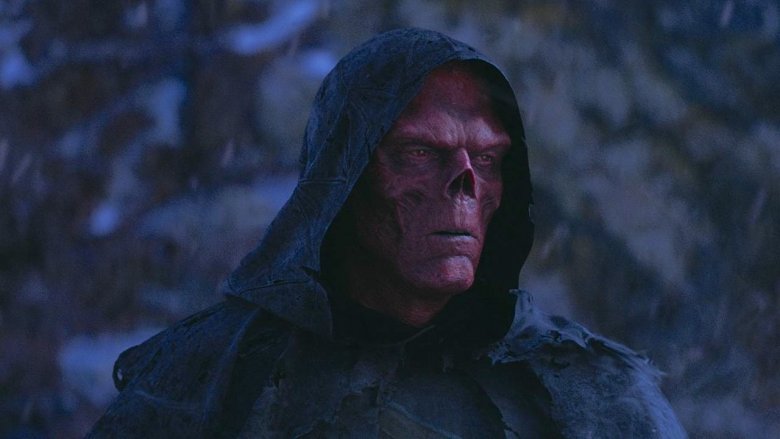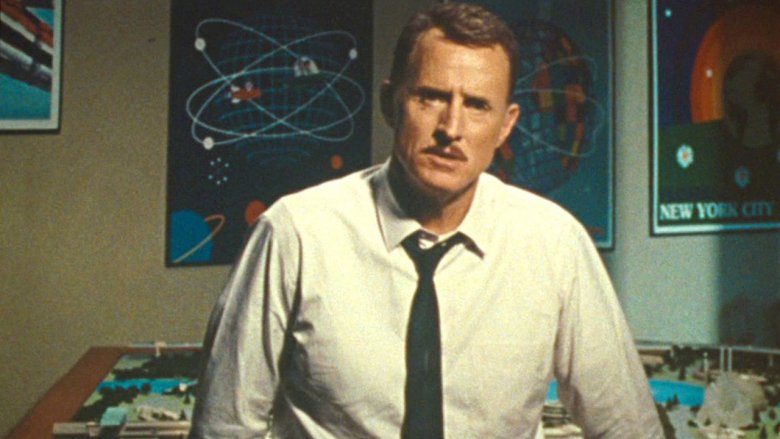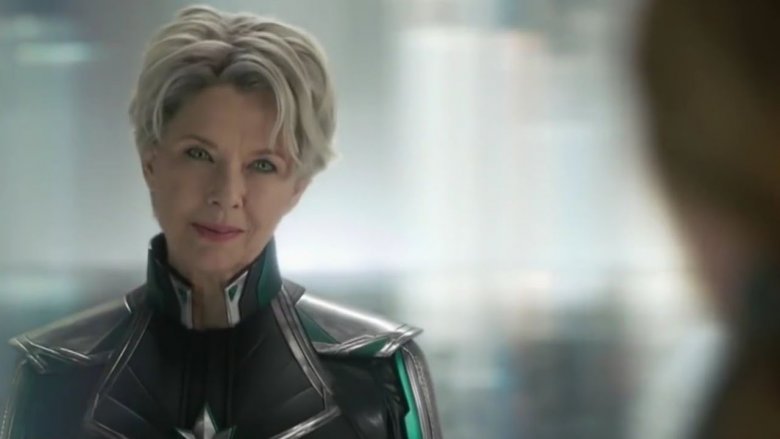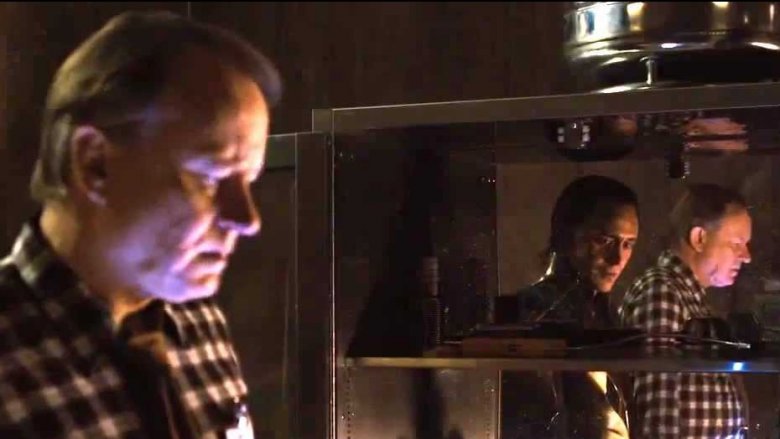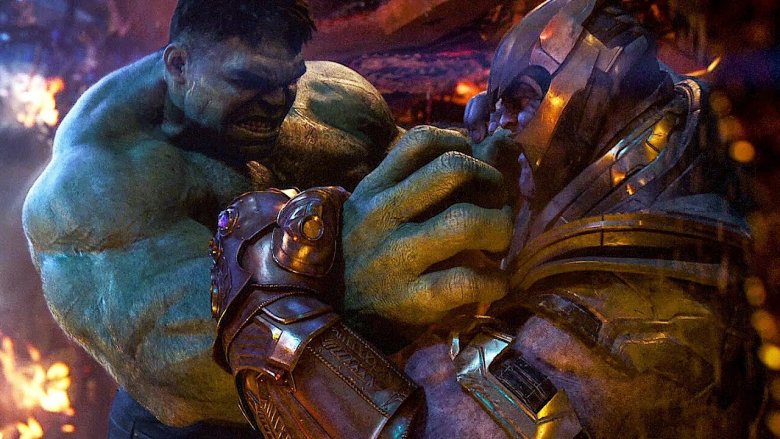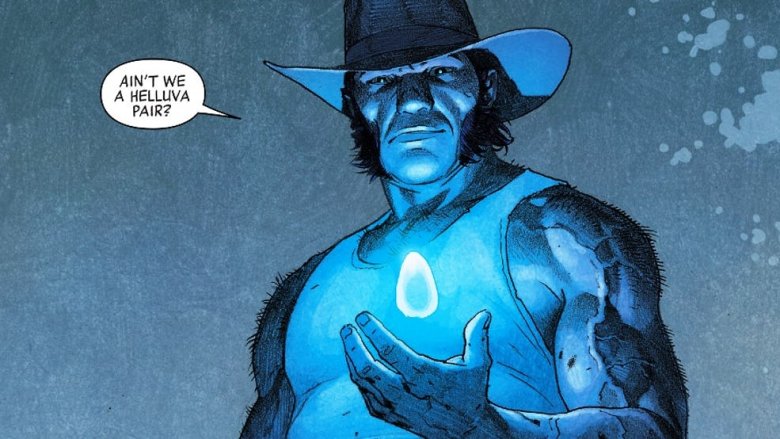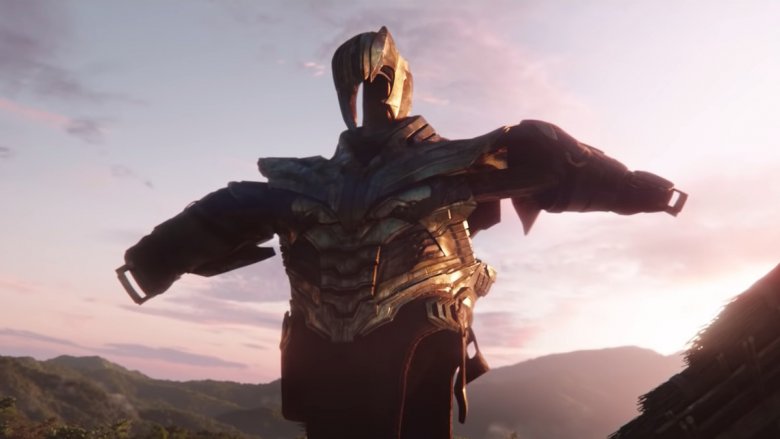The Untold Truth Of The Tesseract
From its first appearance in the Marvel Cinematic Universe as part of a Thor post-credits scene through its role in Marvel Studios' early 2019 blockbuster Captain Marvel, audiences have watched the Tesseract transform from a shiny blue MacGuffin into a legendary artifact with more MCU backstory than a Maximoff twin. For more than a decade, the Tesseract has been a crucial driver of plot and motivation for many of the franchise's major players.
The Tesseract has been depicted as a mysterious box that contains seemingly unlimited power, the ability to create universe-traversing portals, weapons, and lightspeed engines. It's appeared in multiple movies, with Captain Marvel filling in more of the blanks in the narrative than ever before. Let's take a look at lesser-known or little-remembered facts about the origins, powers, and timelines of this vital connective story thread — and remember, of course, that we can't discuss the Tesseract without revealing major spoilers.
Origins
The Tesseract traces its origins as far back as time itself. The Big Bang brought about six primal elemental singularities: Time, Reality, Soul, Mind, Power, and Space. The essence of the universe itself was forged by mysterious cosmic beings into the Infinity Stones. The Space Stone came into the possession of several ancient civilizations, including the Celestials, but only after its power was harnessed by a crystalline cube casing.
The origin of the cube has yet to be revealed, but the cube's purpose was to tame the raw power of the Space Stone, making it more easily controllable. At some point, Odin, the ruler of Asgard, came into possession of the Tesseract and housed it in his own vault, as the crown jewel of his collection of some of the most powerful cosmic weapons and artifacts in the universe. Odin captured and stored in his heavily guarded vault any weapon or relic he thought could possibly bring about end times — or Ragnarok — and the Tesseract definitely fit that bill.
Ragnarok
Ragnarok, according to Norse mythology, is the End of Days: a prophecy of the apocalypse that foresees the destruction of gods, Asgard, and the Realms plunged into darkness. The thrust of the narrative in the Thor trilogy is the prevention of this apocalypse. In Thor: Ragnarok, Thor realizes the prophecy is inevitable, as he releases the demon Surtur to destroy Hela, and bring about Asgard's demise. Thor: Ragnarok was released in 2017, but the Norse concept was introduced to the MCU much earlier — in Captain America: The First Avenger, released in 2011, and set in 1942.
Years before, Odin somehow lost the Tesseract on Earth while defending Midgard from a Frost Giant invasion. It came to be in the possession of a sect of Odin-worshipping monks in Tønsberg, Norway, where it was kept safe for centuries. In the The First Avenger, Red Skull uncovers the Tesseract in Norway. The switch to unlock its hiding place is covered by a carving of Yggdrasil, the World Tree that connects the Nine Realms, and Jormungand, a giant serpent. Jormungand, in mythology, plays a major part in the prophecy of the apocalypse. This Easter egg implies that the Norsemen protecting the Tesseract believed the object to be directly related to Ragnarok.
What happened to the Red Skull?
In The First Avenger, Captain America fought the Hydra super-soldier Red Skull aboard the airship Valkyrie during the film's climactic battle. As the Valkyrie speeds toward New York City armed with nuclear warheads, the fate of the world hangs in the balance. During the brawl, the Red Skull attempts to turn the tables on Cap by barehanding the Tesseract — it doesn't go well for him. A portal opens, blasting Red Skull out of the ship and carrying him off to parts unknown, while the Tesseract burns through the hull of the Valkyrie and descends into the depths of the ocean. Poor Steve Rogers isn't far behind, as the entire airship plunges into the icy water where Captain America would remain frozen for the next 70 years.
Red Skull didn't appear in another MCU movie for nearly a decade before his cameo in Infinity War. In this appearance, the character is portrayed by Ross Marquand of The Walking Dead fame, replacing (and doing a pretty dead-on impression of) The First Avenger's Hugo Weaving. It's revealed that the Space Stone transported Red Skull to Vormir and imprisoned him somehow. The Red Skull explains that his quest to control an Infinity Stone led it to reject him. He's now intrinsically linked to the Soul Stone, as its docent, while never being able to possess it.
Howard Stark
Sometime after Cap's fateful battle with the Red Skull, during an undefined period shortly after World War II, a deep sea expedition led by Howard Stark recovered the Tesseract in the cold waters of the Arctic Ocean while searching for the body of Steve Rogers. This brilliant inventor had been instrumental in creating the scientific process that transformed Rogers from a scrawny weakling into a super soldier. While in possession of the Tesseract, Stark researched and studied its nature.
As mentioned earlier, The Tesseract's official first onscreen appearance comes in a stinger following Thor (2011), but the first Tesseract reference is in Iron Man 2 (2010), which includes a scene in which Howard's son Tony is flipping through his father's notebook when the audience sees a drawing of the Tesseract. Marvel Studios President Kevin Feige confirmed the Easter egg in an interview with Wired, saying, "The trick is, the Easter eggs have to enhance the experience for those who know what they are, but not detract from the experience for those who don't."
Project PEGASUS
Project P.E.G.A.S.U.S. was formed in the 1980s as a joint operation between the United States Airforce and NASA once the Tesseract came to be possessed by the U.S. government. The project had been mentioned in other MCU films, but Captain Marvel was the first to shed more light on the top secret undertaking. Mar-Vell, a Kree scientist posing as human Dr. Wendy Lawson on Earth, is able to obtain access to the Tesseract and attempts to harness its power to produce a lightspeed engine. When a test fighter flown by Carol Danvers and Lawson is shot down by Kree Starforce, Danvers destroys the powerful engine and in the process absorbs the cosmic power of the Space Stone. (The Tesseract itself had been relocated to a hidden research base in Earth's orbit.)
Speaking with ComicBook.com in promotion of Captain Marvel, studio boss Kevin Feige discussed the significance of Project PEGASUS in the MCU. "P.E.G.A.S.U.S. was name dropped ... in Iron Man 2, then it's also at the top of Avengers 1," said Feige. "And it was early on tying her (Captain Marvel) into that early MCU. What do we know about the period of the MCU in the years before Iron Man? Well, the Tesseract and P.E.G.A.S.U.S. were part of it."
What is a Flerken?
As depicted in Captain Marvel, Carol Danvers gains full control of her powers and memories in 1995, six years after her crash and subsequent abduction by the Kree. She's able to thwart her pursuers and uncover the Tesseract in the hidden space station in Earth's near orbit. Once recovered, the Tesseract is kept safe by Mar-Vell's beloved pet "cat," Goose.
Goose is actually a cat-shaped Flerken who stores the artifact in a pocket dimension in her stomach. Flerkens just so happen to resemble Earthly felines in many ways, except for the many toothy tentacles they can release from their mouth. The tentacles enable the deceptively deadly Flerken to devour large prey or objects to teleport or store in stomach lining pocket dimensions. Later, Goose horks up the Tesseract onto Nick Fury's desk, and Project Pegasus is revived to further study the object. It is soon relocated to a SHIELD facility in the Mojave Desert to unlock its full capabilities.
Loki's infiltration
Loki, the trickster god, has always been working one angle or another throughout the course of the MCU's 10+ years of storylines. He's had so many ruses and scams running that it's difficult to recall the details of his relationship to the Tesseract. Following Goose's cosmic hairball deposit in Nick Fury's office, the artifact remained in SHIELD custody for decades. In an end credits scene in Thor (2011), Fury shows the Tesseract to Dr. Selvig, an ally of Thor, and asks him to research it and uncover its potential for potentially unlimited power. Loki, who appeared to have died at the end of the action of the film, is revealed to be skulking nearby, seemingly controlling Dr. Selving's mind.
This inspires Loki to enter into a bargain with the Mad Titan himself, Thanos. The terms were pretty simple — Thanos agreed to lend Loki an Infinity Stone called the Mind Stone, which Loki wielded in his scepter, in order to steal the Tesseract from SHIELD. In exchange, Thanos supplied Loki with an alien army known as the Chitauri to attack and rule Earth. Unfortunately for Thanos and Loki, Earth's Mightiest Heroes got in the way of this plan coming to fruition. The Tesseract was then relocated back to Asgard, returned to Odin's vault for the first time in thousands of years.
Thanos and the Infinity Stones
As first hinted at way back in 2011's Captain America: The First Avenger, The Tesseract does in fact prove itself to play a major part in bringing about the End Times. In Thor: Ragnarok (2017), Loki is able to steal the Tesseract from Odin's vault and summons the demon Surtur as part of a scheme to destroy Asgard. Hulk, Loki, Thor, and Valkyrie, along with a horde of displaced Asgardians, flee the the realm's ruins in possession of the Tesseract — its last custody before being captured by Thanos in Infinity War.
So why do all of these universal happenings seem to center around Earth? What's so special about C-53? There is actually a reason why so many Infinity Stones have been found within proximity to Earth? As referenced earlier with the Red Skull being rejected by the Space Stone and banished to be forever enslaved by the Soul Stone, the Infinity Stones have a kind of sentience — in fact, they are drawn to one another, as if by a sort of magnetism.
Disney-Fox merger
The Disney-Fox merger is now officially, finally complete. With Walt Disney Company, the Thanos of movie studios, completing its $52.4 billion acquisition of 21st Century Fox, we're certainly in the Endgame now. The deal, originally announced in December 2017, more than a year before it was finalized, sees Disney taking on Fox's movie and TV divisions — including the film rights to the X-Men, Deadpool, and Fantastic Four.
In the comics, these former Fox properties have ties to the Tesseract that could have exciting implications for the future of the MCU. For example, in the Ultimate Universe, Reed Richards designs and builds a version of the cube that contains the Tesseract. In Marvel Legacy, it's revealed that the once-dead Wolverine has apparently been revived, and the story insinuates that the Space Stone is partly responsible for his resurrection. Can the Tesseract and the other Infinity Stones continue to act as the narrative threads that hold the MCU together, even while expanding to include the Fox properties? It's not too difficult to imagine that fans certainly hope so.
Legacy of the Tesseract
The Tesseract has appeared in at least 10 Marvel Cinematic Universe films. That's the same amount as central figure Iron Man and one more than everybody's favorite Boy Scout, Captain America. Following the wild success of Joss Whedon's The Avengers, Marvel began to plot its storytelling much more carefully. With the this recalibration, Marvel decided to make the Infinity Stones the central story elements of Phases 1 through 3. As a result, the Tesseract was retconned to contain the Space Stone.
This pivot towards the Infinity Stones as the MCU binding agent will go down in Hollywood history as one of the greatest moves of all time. After years of every other studio in Hollywood looking at the unrivaled Marvel model, attempting to recreate it, and, more often than not, failing, pretenders may be starting to catch on. With a storyline more than 10 years in the making coming to a close with Endgame, it may indeed prove to be the end of an era.
